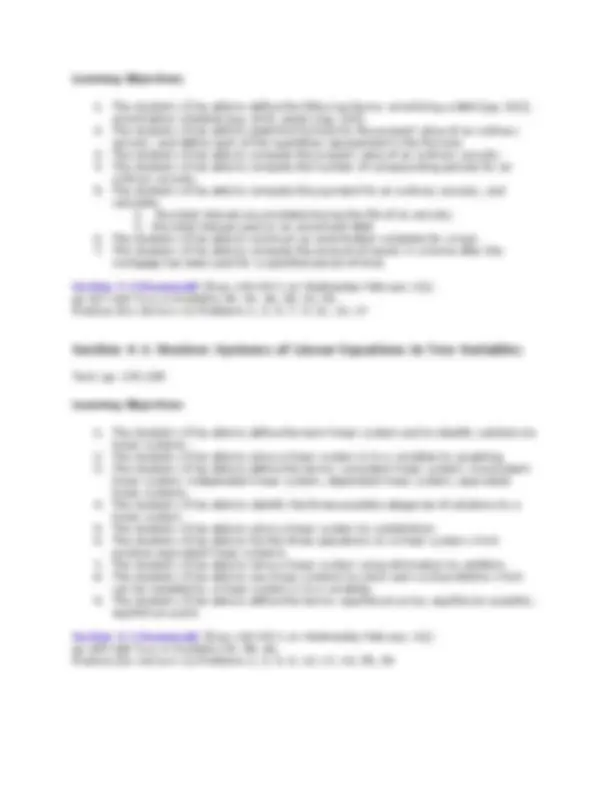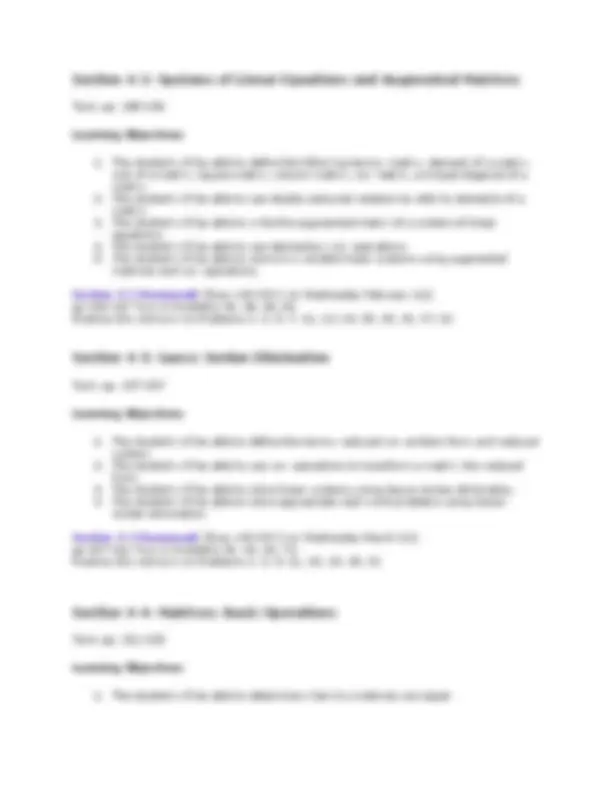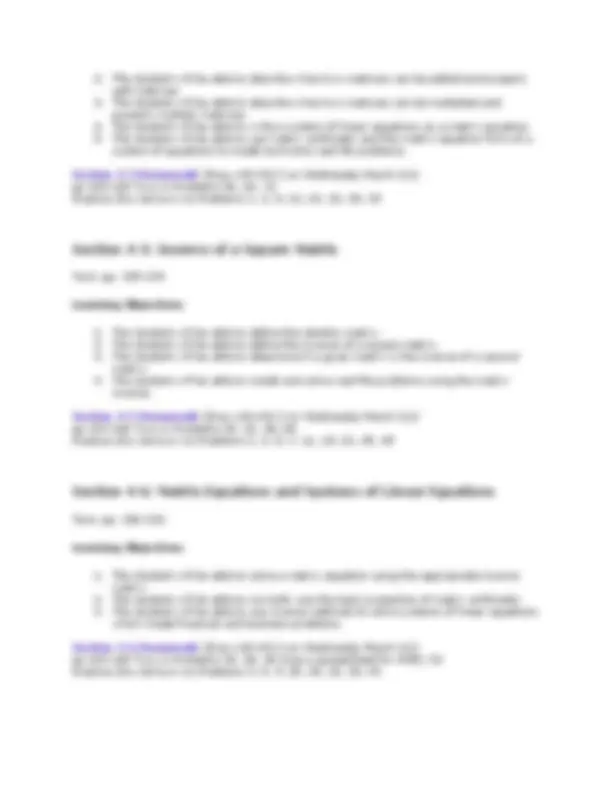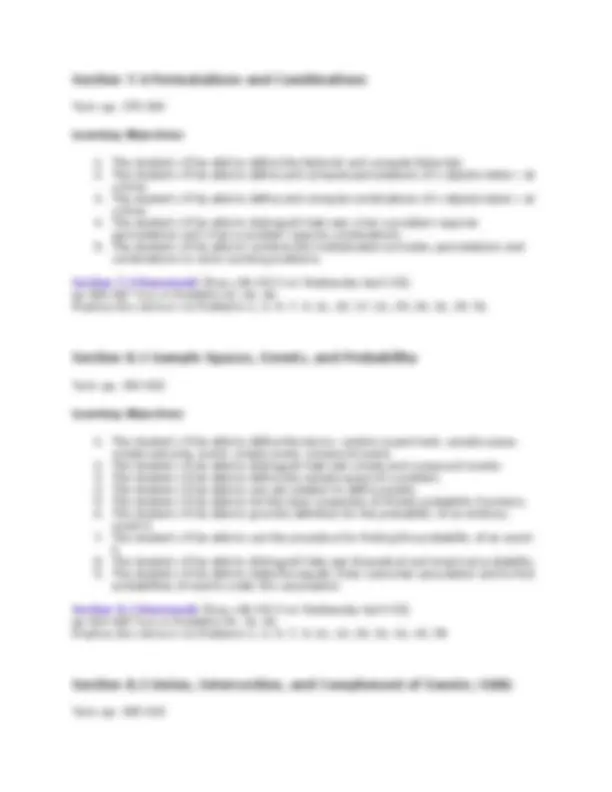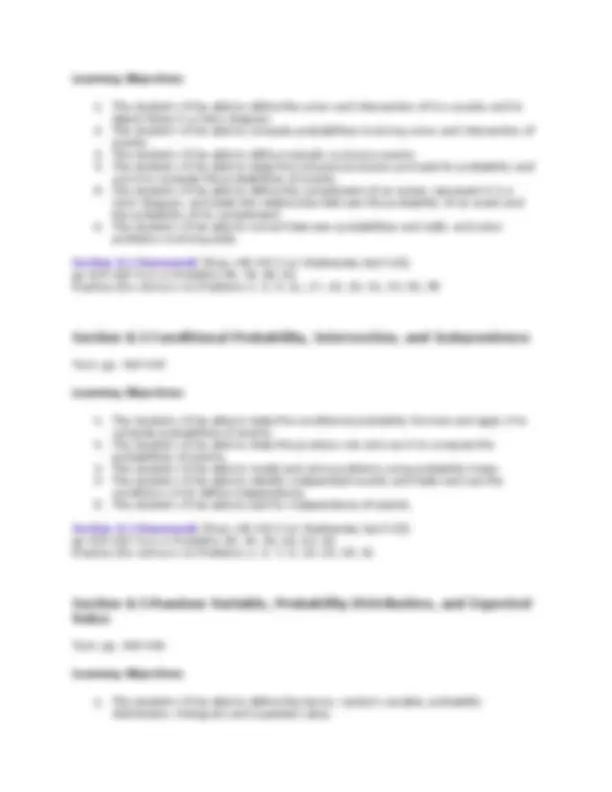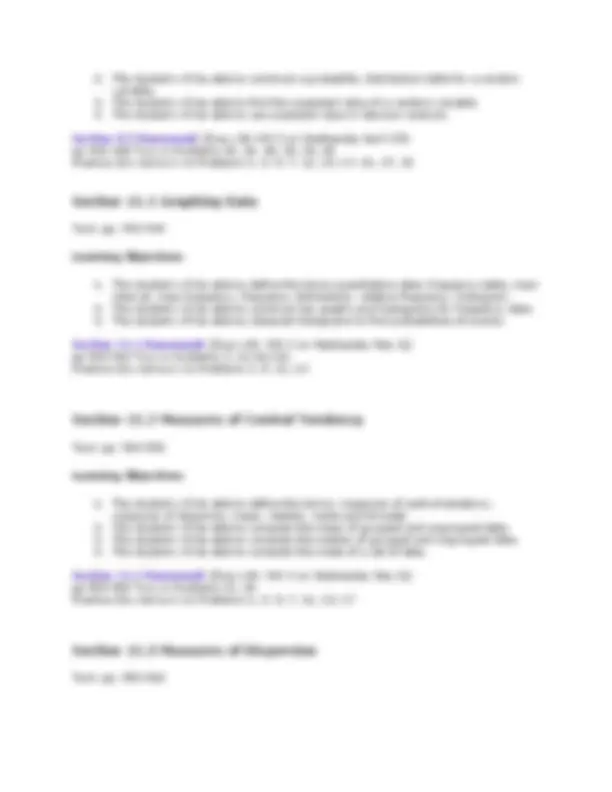Download Learning Objectives and Written Momework List - Finite Mathematics | MATH 1300 and more Assignments Mathematics in PDF only on Docsity!
Math 1300 Learning Objectives and Written Homework List
Spring 2009
Section 3-1: Simple Interest
Text: pp 128-
Learning Objectives
- The student will be able to define the terms principal, interest, interest rate, simple interest, present value and future value.
- The student will be able to use the formula I=Prt to calculate any of the four quantities in the formula when given the other three.
- The student will be able to use the formula A=P(1+rt) to calculate any of the four quantities in the formula when given the other three.
- The student will be able to use the two formulas I=Prt and A=P(1+rt) to solve:
- loan problems [Example 1; Problems 33-44]
- T-bill problems [Examples 2, 3, 4; Problems 45-50]
- stock commission problems [Example 5; Problems 51-54]
- refund anticipation loan problems [Problems 55-61]
Section 3-1 Homework [Due with HW 1 on Wednesday February 11]: pp 132 - 134 Turn in Problems 44, 48, 58
Practice (Do not turn in) Problems 3, 5, 11, 15, 21, 23, 33, 43, 49, 51, 57
Section 3-2: Compound Interest
Text: pp. 134-
Learning Objectives
- The student will be able to define the following terms: compound interest, rate per compounding period, continuous compounding, growth time, annual percentage yield, effective rate of interest and zero coupon bond.
- The student will be able to compute interest rate per period, and use interest rate per period to compute the annual rate.
- The student will be able to use the formula A = P(1+i)n^ to
- compute the future value (A) and interest earned when given the principal amount, the annual nominal interest rate, the number of compounding periods per year, and the length of the investment.
- compute the present value (P) when given the future value, the annual nominal interest rate, the number of compounding periods per year, and the length of the investment.
- The student will be able to use the continuous compound interest formula A = Pert to:
- compute the future value (A) and interest earned of money invested with continuous compounding when given the principal amount, the annual interest rate and the length of the investment.
- compute the present value (P) of money invested with continuous compounding when given the future value, the annual nominal interest rate and the length of the investment.
- The student will be able to compute the annual rate r for money invested with compound or continuous compound interest when given A, P and the length of the investment.
- The student will be able to compute the length of time needed for $P to grow to $A with either compound or continuous compound interest when given A, P, and either the interest rate per period or both the annual rate and the compounding information.
- The student will be able to compute annual percentage yield (APY), and use APY to
- compare investments,
- compute the nominal annual rate.
Section 3-2 Homework [Due with HW 1 on Wednesday February 11]: pp 146-149 Turn in Problems 66, 76, 88, 94, 98. Practice (Do not turn in) Problems 1, 3, 5, 9, 11, 17, 25, 33, 35, 39, 57
Section 3-3: Future Value of An Annuity; Sinking Funds
Text: pp. 149-
Learning Objectives
- The student will be able to define the following terms: annuity [pg. 149], ordinary annuity [pg. 149], future value [pg. 149], balance sheet, sinking fund.
- The student will be able to state the formula for the future value of an ordinary annuity, and define each of the quantities represented in the formula.
- The student will be able to compute the future value of an ordinary annuity, and how much of that future value is due to interest earned.
- The student will be able to compute the payment for an ordinary annuity.
- The student will be able to compute the number of periods for an ordinary annuity.
- The student will be able to construct a balance sheet for an ordinary annuity.
- The student will be able to find the interest earned on an ordinary annuity during any year.
Section 3-3 Homework [Due with HW 1 on Wednesday February 11]: pp 156-157 Turn in Problems 28, 30, 32, 33, 34. Practice (Do not turn in) Problems 1, 3, 5, 9, 11, 13, 17, 33
Section 3-4: Present Value of an Annuity; Amortization
Text: pp. 158-
Section 4-2: Systems of Linear Equations and Augmented Matrices
Text: pp. 188-
Learning Objectives
- The student will be able to define the following terms: matrix, element of a matrix, size of a matrix, square matrix, column matrix, row matrix, principal diagonal of a matrix.
- The student will be able to use double subscript notation to refer to elements of a matrix.
- The student will be able to write the augmented matrix of a system of linear equations.
- The student will be able to use elementary row operations.
- The student will be able to solve two variable linear systems using augmented matrices and row operations.
Section 4-2 Homework [Due with HW 1 on Wednesday February 11]: pp 196-197 Turn in Problems 46, 48, 50, 66 Practice (Do not turn in) Problems 1, 3, 5, 7, 11, 13, 19, 25, 29, 41, 47, 61
Section 4-3: Gauss-Jordan Elimination
Text: pp. 197-
Learning Objectives
- The student will be able to define the terms: reduced row echelon form and reduced system.
- The student will be able to use row operations to transform a matrix into reduced from.
- The student will be able to solve linear systems using Gauss-Jordan elimination.
- The student will be able to solve appropriate real-world problems using Gauss- Jordan elimination.
Section 4-3 Homework [Due with HW 2 on Wednesday March 11]: pp 207-211 Turn in Problems 36, 42, 64, 72. Practice (Do not turn in) Problems 1, 3, 5, 11, 15, 19, 25, 31
Section 4-4: Matrices: Basic Operations
Text: pp. 211-
Learning Objectives
- The student will be able to determine when two matrices are equal.
- The student will be able to describe when two matrices can be added and properly add matrices.
- The student will be able to describe when two matrices can be multiplied and properly multiply matrices.
- The student will be able to write a system of linear equations as a matrix equation.
- The student will be able to use matrix arithmetic and the matrix equation form of a system of equations to model and solve real life problems.
Section 4-4 Homework [Due with HW 2 on Wednesday March 11]: pp 220-225 Turn in Problems 56, 64, 72 Practice (Do not turn in) Problems 1, 3, 5, 13, 19, 23, 29, 39
Section 4-5: Inverse of a Square Matrix
Text: pp. 225-
Learning Objectives
- The student will be able to define the identity matrix.
- The student will be able to define the inverse of a square matrix.
- The student will be able to determine if a given matrix is the inverse of a second matrix.
- The student will be able to model and solve real-life problems using the matrix inverse.
Section 4-5 Homework [Due with HW 2 on Wednesday March 11]: pp 234-236 Turn in Problems 18, 22, 38, 68 Practice (Do not turn in) Problems 1, 3, 5, 7, 11, 15, 21, 35, 45
Section 4-6: Matrix Equations and Systems of Linear Equations
Text: pp. 236-
Learning Objectives
- The student will be able to solve a matrix equation using the appropriate inverse matrix.
- The student will be able to correctly use the basic properties of matrix arithmetic.
- The student will be able to use inverse methods to solve systems of linear equations which model financial and business problems.
Section 4-6 Homework [Due with HW 2 on Wednesday March 11]: pp 242-245 Turn in Problems 20, 28, 48 (Use a spreadsheet for #48), 52 Practice (Do not turn in) Problems 3, 5, 9, 25, 29, 22, 29, 49
- The student will be able to follow the 5 step procedure for constructing a model for an applied linear programming problem.
- The student will be able to follow the 4 step procedure for geometrically solving a linear programming problem with two decision variables.
- The student will be able to apply these techniques to model and solve appropriate real-world financial and business problems.
Section 5-3 Homework [Due with HW 2 on Wednesday March 11]: pp 285-289 Turn in Problems 22, 34, 42 Practice (Do not turn in) Problems 3, 7, 9, 11, 13, 15, 23, 29
Section 7.2: Sets
Text: pp. 360-
Learning Objectives
- The student will be able to define the terms: set, member or element of a set, empty set, finite set, infinite set.
- The student will be able to identify what it means for a set to be equal to another set or a subset of another set.
- The student will be able to interpret and apply set notation.
- The student will be able to define and use the set operations of union, intersection and complement.
- The student will be able to identify the universal set in problems.
- The student will be able to identify when two sets are disjoint.
- The student will be able to use Venn diagrams to solve problems involving applications of sets.
Section 7.2 Homework [Due with HW 3 on Wednesday April 15]: pp 364-366 Turn in Problems 44, 86, 92 Practice (Do not turn in) Problems 1, 3, 5, 7, 11, 15, 17, 21, 31, 53, 55
Section 7.3 Basic Counting Principles
Text: pp. 366-
Learning Objectives
- The student will be able to state and apply the addition principle for counting.
- The student will be able to model and solve problems using Venn diagrams.
- The student will be able to state and apply the multiplication principle.
Section 7.3 Homework [Due with HW 3 on Wednesday April 15]: pp 372-375 Turn in Problems 56, 58, 60, 64 Practice (Do not turn in) Problems 1, 3, 7, 13, 19, 21, 23, 27, 47
Section 7.4 Permutations and Combinations
Text: pp. 375-
Learning Objectives
- The student will be able to define the factorial and compute factorials.
- The student will be able to define and compute permutations of n objects taken r at a time.
- The student will be able to define and compute combinations of n objects taken r at a time.
- The student will be able to distinguish between when a problem requires permutations and when a problem requires combinations.
- The student will be able to combine the multiplication principle, permutations and combinations to solve counting problems.
Section 7.4 Homework [Due with HW 3 on Wednesday April 15]: pp 385-387 Turn in Problems 62, 64, 66 Practice (Do not turn in) Problems 1, 3, 5, 7, 9, 11, 15, 17, 21, 25, 29, 31, 39, 51
Section 8.1 Sample Spaces, Events, and Probability
Text: pp. 392-
Learning Objectives
- The student will be able to define the terms: random experiment, sample space, simple outcome, event, simple event, compound event.
- The student will be able to distinguish between simple and compound events.
- The student will be able to define the sample space of a problem.
- The student will be able to use set notation to define events.
- The student will be able to list the basic properties of (finite) probability functions.
- The student will be able to give the definition for the probability of an arbitrary event E.
- The student will be able to use the procedure for finding the probability of an event E.
- The student will be able to distinguish between theoretical and empirical probability.
- The student will be able to state the equally likely outcomes assumption and to find probabilities of events under this assumption.
Section 8.1 Homework [Due with HW 3 on Wednesday April 15]: pp 403-405 Turn in Problems 54, 76, 92 Practice (Do not turn in) Problems 1, 3, 5, 7, 9, 11, 13, 15, 31, 41, 43, 55
Section 8.2 Union, Intersection, and Complement of Events; Odds
Text: pp. 405-
- The student will be able to construct a probability distribution table for a random variable.
- The student will be able to find the expected value of a random variable.
- The student will be able to use expected value in decision analysis.
Section 8.5 Homework [Due with HW 3 on Wednesday April 15]: pp 446-448 Turn in Problems 20, 26, 28, 30, 36, 40 Practice (Do not turn in) Problems 1, 3, 5, 7, 11, 15, 17, 21, 27, 31
Section 11.1 Graphing Data
Text: pp. 532-
Learning Objectives
- The student will be able to define the terms quantitative data, frequency table, class interval, class frequency, frequency distribution, relative frequency, histogram.
- The student will be able to construct bar graphs and histograms for frequency data.
- The student wlll be able to interpret histograms to find probabilities of events.
Section 11.1 Homework [Due with HW 4 on Wednesday May 6]: pp 540-544 Turn in Problems 2, 16 (A)-(D) Practice (Do not turn in) Problems 1, 5, 11, 13
Section 11.2 Measures of Central Tendency
Text: pp. 544-
Learning Objectives
- The student will be able to define the terms: measures of central tendency, measures of disperson, mean, median, mode and bimodal.
- The student will be able to compute the mean of grouped and ungrouped data.
- The student will be able to compute the median of grouped and ungrouped data.
- The student will be able to compute the mode of a set of data.
Section 11.2 Homework [Due with HW 4 on Wednesday May 6]: pp 552-554 Turn in Problems 14, 20 Practice (Do not turn in) Problems 1, 3, 5, 7, 11, 13, 17
Section 11.3 Measures of Dispersion
Text: pp. 554-
Learning Objectives
- The student will be able to define the range of a data set (both grouped and ungrouped).
- The student will be able to find the sample variance of a set of sample data (both grouped and ungrouped).
- The student will be able to find the variance of a set of population data (both grouped and ungrouped).
- The student will be able to find the standard deviation of a set of data (both grouped and ungrouped).
Section 11.3 Homework [Due with HW 4 on Wednesday May 6]: pp 560-561 Turn in Problems 14, 18 Practice (Do not turn in) Problems 1, 3, 5, 7, 11
Section 11.4 Bernoulli Trials and Binomial Distributions
Text: pp. 562-
Learning Objectives
- The student will be able to state the conditions for a sequence of experiment trials to be a Bernoulli or binomial experiment.
- The student will be able to find the probability of an outcome of a binomial experiment.
- The student will be able to state the formula for the probability of exactly x successes in n independent repeated binomial trials.
- The student will be able to state and use the binomial theorem.
- The student will be able to define the term binomial distribution.
- The student will be able to construct tables and histograms for binomial distributions.
- The student will be able to find the mean and standard deviation of a binomial distribution.
- The student will be able to apply binomial distributions to real world problems.
Section 11.4 Homework [Due with HW 4 on Wednesday May 6]: pp 570-572 Turn in Problems 18, 26, 44, 46, 50 Practice (Do not turn in) Problems 1, 3, 5, 7, 9, 11, 13, 15, 19, 21, 29
Section 11.5 The Normal Distribution
Text: pp. 572-
Learning Objectives
The student will be able to
- explain the difference between discrete and continuous random variables;

